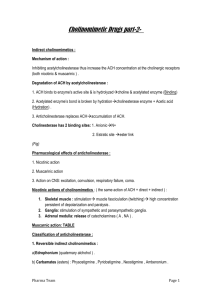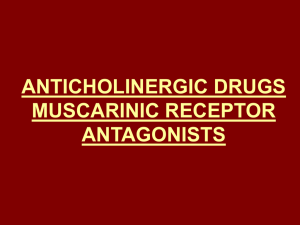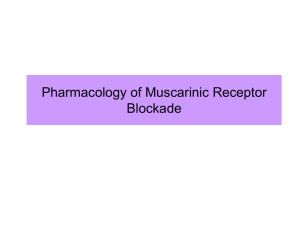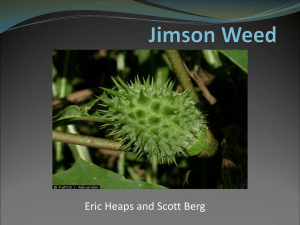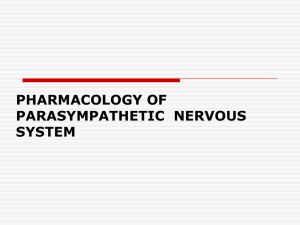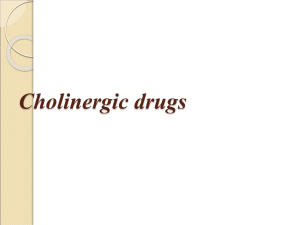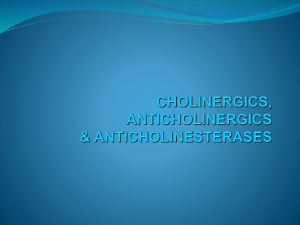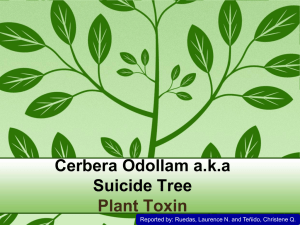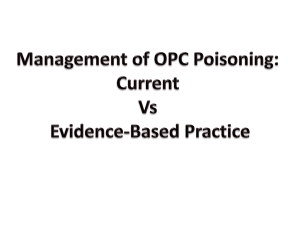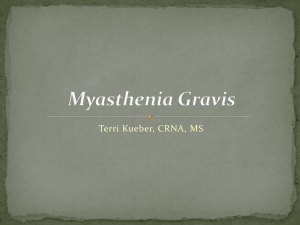عرض تقديمي من PowerPoint
advertisement
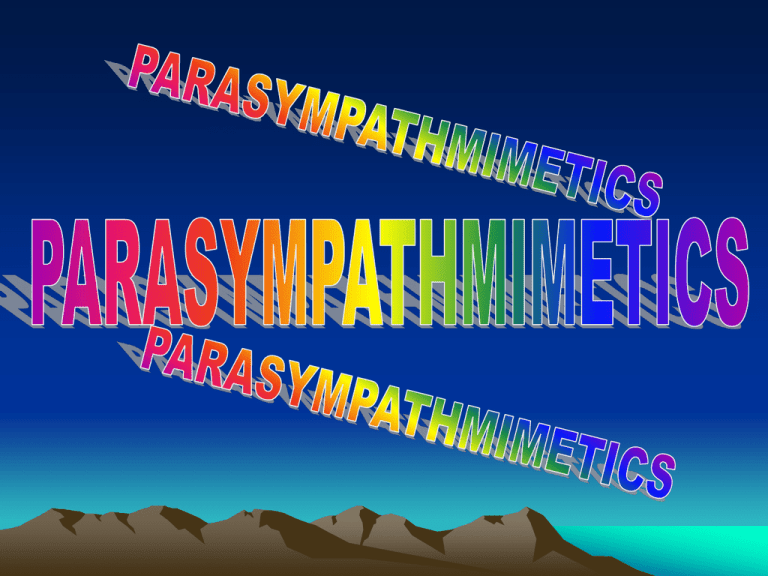
CHOLINOMIMETICS, MUSCARINIC AGONISTS, CHOLINOCEPTIVE AGONISTS A) Direct Parasympathomimetics: • 1-Choline Esters: a- Acetylcholine c-Carbachol. b- Methacholine. d-Bethanechol. 2-Cholinomimetic Alkaloids: a- Pilocarpine. b-Muscarine. c-Arecoline. d. oxotremorine • B) Indirect Parasympathomimetic (AntiCholinesterases): • They inhibit cholinesterase enzymes ( and include both TRUE and Pseudocholinesterasea). • They causes an accumulation of the endogenous A.Ch. leading to the stimulation of both the Muscarinic and Nicotinic receptors to provide the corresponding actions. 1-Reversible Anti-Cholinesterasees: a- Quaternary Alcohols : Edrophonium. It is not a substrate for the Enzyme. b- Carbamate Derivatives. Are Substrate for the Enzyme. -Physostigmine. -Neostigmine. - Pyridostigmine . 2-Irreversible Anti-Cholinesterases (Organophosphorus Compounds): Non-competitive Irreversible inhibition of enzyme. a. Di- isopropyl flurophosphate (DFP ) b. Echothiophate, used as eye drops in the treatment of glaucoma c. Tetraethyl pyrophosphate (TEPP) d. Nerve gases ( Tabun, Sarin & Soman ) e. Agricultural Insecticides ( Parathion, Malathion & Fenthion) f. Metrifonate used in treatment of urinary bilhaziasis A- Choline Esters: 1- Acetylcholine : Synthesis: a- Active Uptake of Choline by Cholinergic Varicosity (Rate Limiting Step) N.B. hemicholinium Inhibits Neuronal Uptake of Choline. b- In Mitochondria of Cholinergic Nerve Terminal (Varicosity): Acetate + Co. A + ATP Acetyl Co. A + ADP c-In Cytoplasm of cholinergic Nerve Ending (Varicosity): Choline + Acetyl Co.A Acetylcholine + Co.A Absorption and Fate : a. ACh is ineffective orally and be given parenterally. b. Rapidly hydrolyzed in the blood and tissues to choline and acetic acid by the enzyme cholinesterase. Types of cholinesterase : There are two types of cholinesterase : a. True cholinesterase: - occurs in the CNS , red blood cells and in all cholinergic structures. - it is responsible for the hydrolysis of ACh released at the cholinergic sites. b. Pseudocholinesterase: - It occurs in the liver and plasma. - It hydrolyzes drugs with structural similarity to Ach. - The enzyme has two active sites, the anionic site ( containing glutamate ) and the estratic site which contains serine amino acid Properties of Ach: • Very short duration of action because of its rapid hydrolysis by both enzymes. • Not used as a drug. • Not be given orally. Pharmacological Actions of Acetylcholine There are two main actions called: 1- Muscarinic actions 2- Nicotinic actions. 1 - Actions on The Cardiovascular System: A- On the heart : a- Negative Chronotropic SAN decreases The heart rate (Bradycardia). b- Negative inotropic on Atrium (decreases the force of contraction). c- Negative Dromotropic ( A-V Conduction).This will reduce the cardiac output B- On the blood vessels: A.Ch. + Non - innervated muscarinic receptors on Intact Endothelium releases Endothelium Derived Relaxing Factor (EDRF, Nitric Oxide) increases the cGMP levels vasodilatation. C. Blood pressure: Caues fall in blood pressure as a result of the bradycardia and vasodilatation. The induced vasodilatation of both peripheral and systemic blood vessels leads to; a- Reduction of the systemic ABP b- Reduction of the PVR c- Reduction of the blood flow to some organs e.g. kidney and the liver 2- Actions on Gastrointestinal tract: a- Motility : Stimulation b- Sphincters : Relaxation c- Secretions : Increase 3- Urinary bladder: (Evacuation) a- Detrusor Muscle : Contraction ( urination) b- Sphincters : Relaxation ( urination) 4- Eye : a- Circular Muscles ( M3) : Contraction ( Miosis) b- Ciliary Muscles (M3) : Contraction for near vision ( to see the near objects) 5- Glands: Sweat, salivary and lacrymal : Stimulation to increase secretions. 6- Lung : a- Bronchial Muscles: Contraction ( Bronchoconstriction) b- Bronchal glands : Stimulation ( Increased secretions) 1-Stimulation of Autonomic Ganglia and Adrenal Medulla (Nn) a. Acetylcholine stimulates the autonomic ganglia, resulting the release of noradrenaline from the sympathetic nerve endings . b. Stimulation of the adrenal medulla release of adrenaline and noradrenaline . This effect is blocked by the ganglionic blockers, hexamethonium 2- Motor end plate (Nm): Acetylcholine induces muscle twitching. This effect is blocked by the neuromuscular junction blocker decamethonium and flaxedil. Acetylcholine reversal: In presence of atropine; high doses of acetylcholine produce an increase in blood pressure instead of a decrease. Therapeutic uses of Ach: Not used therapeutically because of: a. Its multiplicity in action, b. Its rapid inactivation by cholinesterase enzymes. c. Being ineffective orally. • Except during cataract , it produces immediate brief miosis 2- Synthetic Cholinomimetic esters : They are characterized by 1. More stable than ACh 2. More selective than Ach 3. Have longer duration of action 4. Active orally and parentrally They can be prepared either by 1. B-methylation, increases the muscarinic activity. 2. Addition of carbamate increases the stability and resist the enzymatic hydrolysis. Properties: 1- ALL are quaternary ammonium compounds 2- More specific. 3- Less metabolised: Hence have longer duration of action and Effective Orally. 4- NEVER be injected I.V. or I.M. toxicity is abolished by ATROPINE. Contraindicated in: a- Bronchial asthma (Bronchospasm and increased secretion). b- Peptic Ulcer Secretions). (Gastric Acid c- Angina Pectoris (Hypotension reduction of coronary blood Flow). d- Thyrotoxicosis Fibrillation). (Atrial Therapeutic Uses of methacholine 1. Paroxysmal atrial tachycardia 2. Raynaud's disease 3.Diagnosis of atropine (Belladonna) toxicity How? Because Normally when injected, It causes colics, salivation, lacrimation, sweating. These symptoms do not appear in case of atropine toxicity Uses of carbachol: Used for treatment of Glaucoma and cataract extraction. Uses of Bethanechol ( Urecholine ) 1. Paralytic ileus 2. Post operative retention of urine, in absence of mechanical obstruction 3. Gastric atony 4. Glaucoma A- Methacholine : a- Its nicotinc actions are not clear b- It has longer duration of action c- Its muscarinic actions are more prodominent on the cardiovascular system than on GIT and urinary bladder. B- Carbamylcholine ( Carbachol): a- It has a longer duration of action b- Its nicotinc action is nearly similar to Ach c- Its muscarinic actions are more prodominent on the eye , urinary bladder and GIT. C-Bethanechol ( Urecholine) : It is completely similar to that of carbachol , but the main difference is that it does not have nicotinic actions. II- Cholinomimetic Alkaloides : Pilocarpine Pilocarpine is a direct prasympathomimetic tertiary amine. a. It is a naturally occurring alkaloid obtained from Pilocarpus jaborandi leaf. b. It is readily absorbed from the GIT. c. Inactivated by cholinesterase enzyme . d. It has longer duration of action. e- Passes the B.B.B (Avoids in Parkinsonism). f- Excreted in urine. Pharmacological actions A. Eye: Locally in the eye as eye drops, it produces: a. Miosis b. Contraction of the ciliary muscle leading to accomodation for near objects c. Decreases the intra-ocular pressure. B. Exocrine glands Increases the secretion of the exocrine glands especially salivary (sialagogue action) and sweat (diaphoretic action) Smooth muscles . C It increases the tone and motility of the GIT, urinary bladder and bronchoconstriction. Therapeutic uses : 1. Treatment of glaucoma, the drug of choice in the emergency of the increased IOP in both open and closed angel glaucoma. 2. To counteract the mydriatic effect of atropine, homatropine and eucatropine . 3. Alternately with mydriatics to break adhesions between the iris and lens 4. To stimulate salivation in dry mouth ( xerostomia) 5. Treatment of atropine overdosage. They are indirectly acting cholinomimetics. They block the enzymatic hydrolysis of acetylcholine, by inhibition of acetylcholinesterase and plasma pseudocholinesterase. They increase the local acetylcholine concentrations and Accumulation of the endogenous A.Ch. inducing both the Muscarinic and Nicotinic actions. 1-Reversible Anti-Cholinesterasees: They weakly inhibit acetylcholinesterase by reversible association with the anionic site and hindering access to acetylcholine 2-Irreversible Anti-Cholinesterases: (Organophosphorus Compounds): These agents act by covelantly phosphorylating the hydroxyl group of serine on the enzyme. 1. Reversible anticholinesterases: a. Short acting: Edrophonium: it is mainly used for diagnostic purposes b. Medium acting: - Physostigmine: - It is a natural alkaloid). (tertiary amine). - Absorbed from the GIT and pass the BBB producing central stimulation. - Neostigmine (prostigmine), has a direct stimulant effect on skeletal muscles. - Pyridostgmine - Tacrine, Donepezil, Rivastgmine, galantamine ( 3ary amines in Alzheimer) - Ambenomium , - Demecrium and Benzyrinium. Mechanism of action A. Short acting: • Compete with ACh for the active sites on the true and pseudocholinestrases . • Bind to the anionic site of the enzyme with ionic bond so they have brief and short duration. B.Medium acting - They bind to the anionic site and estratic site of the enzyme. - The carbamylated enzyme has a slower rate of hydrolysis and recovery. - The duration of action of these drugs is relatively longer. Neostgmine: 2-4 h, Pyridostgimine: 3-6 h. 2. Irreversible anticholinesterases: (Organic phosphate esters) a. Diisopropylflurorophosphate (DFP) (Isoflurophate) b. Tetraethylpyrophosphate c. Ecothiophate d. Insecticides e.g. parathion e. Nerve gases e.g. sarin, tabun and soman. Mechanism of action 1. They bind to the serine OH group in the estratic site . 2. The inactivated phopshorylated enzyme is very stable. 3. The recovery of the enzyme activity depends on the synthesis of new one. It takes few weeks ( Reactivation of the nonaged enzyme may be occurred by cholinesterase reactivator. pralidoxime (PAM). 4. War gases and pesticides interact only with the estratic site of the enzyme and have no anionic. Ecothiophate which binds also to the anionic site. Pharmacological actions I. Muscarinic actions 1. Cardiac muscles: bradycardia and decrease conductivity 2. Smooth muscles a. Eye: iris: miosis due to contraction of circular muscles ciliary muscles: contraction and accommodation for near vision. b. Bronchi: bronchoconstriction and stimulation of secretion c. GIT: increase tone and motility and stimulation of gastric secretions d. Urinary bladder: evacuation of the bladder and urination. 3. Exocrine glands: Stimulation of sweat, salivary and lacrymal secretions. II. Nicotinic actions: 1. Skeletal muscles: These drugs potentiate the action of Ach on the muscle by their anticholinesterase activity. 2. Autonomic ganglia: no marked effect. III. Effect on the CNS Tertiary compounds as physostigmine, tacrine and donepezil pass the blood brain barrier. They produce symptoms of CNS stimulation as restlessness, insomnia, tremors and convulsions followed by depression. These effects are: - Due to the activation of the muscarininc receptors. - Antagonized by atropine. - Greater with irreversible anticholinesterase compounds. Therapeutic uses: 1. Diagnosis and treatment of myasthenia gravis 2. Treatment of glaucoma (eserine, demecarium) 3. Teatment of postoperative paralytic ileus and urine retention (benzpyrinium) 4. Antidote for atropine poisoning 5. Alzheimer (tacrine and donepezil) 6. To counteract the mydriatic effect of homatropine and eucatropine 7. Alternatively with mydriatic to break adhesion between iris and lens. 1. Diagnosis and treatment of myasthenia gravis What is myasthenia gravis? Myasthenia Gravis mean "Grave muscle weakness." Myasthenia gravis is a auto-immune disorder, characterized by progressive muscle fatigue and weakness. Usually involves muscles around the eyes, mouth, throat and limbs. A. A disease of impaired neuromuscular transmission. B. Characterized by weakness and rapid fatigability of the skeletal muscle, drooping of the upper eye lid (ptosis). C. Usually occurs between age group of 20 and 40, and more common in women. D. This disease affects 1:2000 individuals, 100,000 case in USA. Etiology: 1. Autoimmune disease, due to the presence of antibodies against Ach receptor protein. 2. The presence of circulating curare-like substances. 3. A defective rate of synthesis of acetylcholine. 4. Excessive amount of acetylcholinesterase in the neuromuscular junction. Myasthenia gravis occurs when the immune system makes antibodies that damage or block many of the muscle's acetylcholine (ACh) receptors on the surface of muscle cells. This prohibits ACh from binding to the damaged receptors and acting on the muscle, which reduces muscle contractions, leading to weakness and fatigue. There are enough number of acetylcholine receptor transmitting the signal from the nerve to the muscle. Antibody (Y-shaped) binds and reduces the number of acetylcholine receptor and makes the transmission of the signal difficult A.Diagnosis of Myasthenia gravis • Administration of edrophonium (IV) which is a short acting anticholinesterase. B.Treatment of Myasthenia gravis a. Anticholinesterases • Neostigmine: • It has a direct action on the muscle. It is used in combination with atropine to block the unwanted muscarinic effects. • Pyridostgmine (Neostgmine substitutes, mestinone) • Ambenonium: More selective on the skeletal muscles, effective orally, longer duration of action (advantage over neostgmine) b. Azathioprine ( immunosuppressant agent). c. Thymectomy d. Plasma exchange e. Prednisolone ( as corticosterids) 2. Treatment of glaucoma (eserine, demecarium) 3. Teatment of postoperative paralytic ileus and urine retention (benzpyrinium) 4. Antidote for atropine poisoning 5. Alzheimer (tacrine and donepezil) 6. To counteract the mydriatic effect of homatropine and eucatropine 7. Alternatively with mydriatic to break adhesion between iris and lens. . These are drugs that block the peripheral muscarinic receptors. . They inhibit the muscarinic actions of acety -lcholine and other parasympathomimetics. They include: a-Naturally occurring Belladonna alkaloids e.g. Atropine, Hyoscine ( Scopolamine) b- Atropine substitutes I. Atropine Pharmacological Actions of Atropine : 1. Actions on the smooth muscles A. Eye: B. Bronchi: C. Gastrointestinal tract: D. Urinary tract: E. Blood vessels F. Exocrine Glands: A. Eye: • Local application of atropine in the eye or its systemic administration produces: a. Mydriasis due to paralysis of the constrictor pupillae muscle containing M3 receptors ( passive mydriasis) b. Paralysis of the ciliary muscle (cycloplegia) leading to loss of accomodation to near objects. c. Increased intra-ocular tension due to closure of the canal of Schlemm and obstruction of the spaces of Fontana d. Loss of the light reflex e. Inhibition of lacrimation • The duration of action of atropine following its local application to the eye is 7 – 10 days. B. Bronchi: Bronchodilation and reduction of bronchial secretion C. Gastrointestinal tract: a. Reduction of tone and motility of the GIT b. Reduction of gastric secretion (volume and total acid content) D. Urinary tract: a. Ureter: antispasmodic b. Urinary bladder: relaxation of the detrusor muscle, contraction of the sphincter and trigone leading to retention of urine. E. Blood vessels a. Therapeutic doses do not produce significant action on the blood vessels and blood pressure b. Toxic doses: dilatation of cutaneous blood vessels especially those in face area (Atropine flush). F. Exocrine Glands: - Reduction of salivary secretions producing dry mouth - Reduction of the Lachrymal secretion - Reduction of sweating producing dry skin and arise of body temperature (atropine fever) and is usually observed after toxic doses of atropine. 2. Action On The Central Nervous System: Stimulant Actions : a. Stimulation of the respiratory center causing respiratory stimulation b. High doses stimulate the Cerebral cortex leading to restlessness, hallucinations and delirium. This central excitation is followed by depression Depressant Actions: a- Decreased tremors and rigidity, so can be used in treatment of parkinsonism b- Inhibits vomiting centers : Antiemetic action 3. Cardiovascular system: Heart: a. Small doses: bradycardia due to blockade of M1 receptors on the inhibitory prejunctional neurons thus increasing the release acetylcholine. b. Large doses produce tachycardia due to blocking of the postsynaptic M2 receptors Therapeutic uses: 1- Preanesthetic medication: Half an hour before general anesthesia : a. Decrease salivary and bronchial secretions b. Protect the heart from excessive vagal tone c. Counteract the inhibitory effect of morphine on the respiratory center 2- Antispasmodic in cases of intestinal , biliary and renal colics 3- In case of Heart block due to myocardial infarction , over dose of digitalis or propranolol. 4- Treatment of severe bradycardia 6- Hyperhidrosis (excessive sweating) 7- locally in the eye: a. In cases of iris and corneal ulcer to prevent the adhesions b. In alternations with miotics to breakdown recent adhesions between the iris and lens 8- Antidote to parasympathomimetics poisoning e.g. organophosphorus poisoning. 9- In case of Parkinsonism 10- To treat Peptic ulcer 11- Bronchial asthma: however, it has the disadvantage that the sputum becomes viscid and more difficult to expel. 12- Nocturnal enuresis Side Effects: 1. Dryness of mouth , blurred vision and tachycardia 2. Retention of urine may occur in patients with enlarged prostate 3. Acute glaucoma may be precipitated 4. In children, cutaneous vasodilatation with flushing of the skin and elevation of body temperature Contraindications 1. It can precipitate an acute attack of glaucoma. 2. Patients with enlarged prostate as atropine may precipitate urine retention. 2. Hyoscine (Scopolamine): 1. It has a CNS depressant effect and usually causes drowsiness and euphoria. 2 .It has a depressant action on vestibular function and is useful in the management of motion sickness and Meniere disease. 3. It produces amnesia and was used with morphine to produce a state of twilight sleep during delivery. 4. In parkinsonism, hyoscine has antitremor activity therefore reducing tremors Synthetic Atropine substitutes 1- Mydriatic Atropine substitutes: They have shorter duration of action • 1. Homatropine • 2. Eucatropine • 3. Cyclopentolate • 4. Tropicamide 2- Antisecretory – Antispasmodic Atropine substitutes: – Propantheline, – Oxyphenonium, – Hyoscine butylbromide – Glycopyrrolate, – Dicyclomine • They are used for treatment of spasms of the GIT, bile duct and urinary tract Pirenzepine & telenzepine : these drugs are selective M1 receptor antagonists , used in the treatment of peptic ulcer. 3- Antiparkinsonism – atropine substitutes 1. Trihexphenidyl 2. Benztropine (cogentin) 3. Biperiden 4- Decreasing urinary bladder activity A. Oxybutynin: to relieve bladder spasm after urologic surgery and to reduce involuntary voiding in patients with neurologic disease. B. Tolterodine, an M3- selective antimuscarinic, is used in adults with urinary incontinence. C. Propiverine 5- Atropine substitutes used in bronchial asthma • Ipratropium • It has more selective bronchodilators effect with a lesser action on sputum viscosity. • It can be used in combination with 2 agonists as a bronchodilators in asthma.
